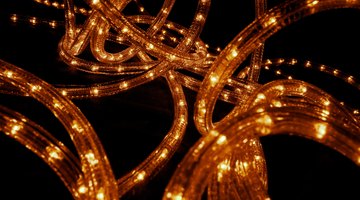How to Cut Rope Lights
Many decorative lighting effects can be achieved using rope lights. Installed behind crown molding, rope lights become cove lighting, creating a warm glow against the ceiling. These lights can also serve both under and above cabinets. Rope lights commonly serve as decorative holiday lighting.

Most do-it-yourself lighting projects using rope lights require the lights to be cut to custom lengths. The lights can be cut only at precise intervals -- which vary according to the type of lights you are using -- typically every 18, 24, 36 or 39 inches.
-
Locate the nearest cutting mark, typically indicated by a dotted line or scissor icon, according to the length of light you need. Look for two small wires on either side of the cutting mark, making sure the cut is in between each of them, either on the line or right next to it.
-
Use a utility knife, wire cutters or scissors to make a clean, straight cut through the rope light.
-
Attach the power connector to the power cord by inserting the two pins on the connector into the two holes on the cord. Secure the two pieces by threading the attached collar in place.
-
Open the attached plastic flanges or separate the screw compression cover on the power connector, depending on its design. Slide the cover or plastic nut onto the rope light and line up the pins on the connector to the wires inside the rope light. Slide the pins gently into the wire holes on the light, making sure the wires connect with the pins.
-
Plug the power cord into a standard wall outlet briefly to make sure the pins and wires are connecting. Unplug the cord and screw the cover or nut in place to secure the power cord to the light.
-
Place the end cap on the other end of the rope light to seal off the wire holes. Plug the power cord back into the wall outlet.
Things You Will Need
- Rope lights
- Utility knife, wire cutters or sharp scissors
- Power connector
- Power cord
- End cap
Tip
LED rope lights require electrical current to flow in a particular direction. If your connection is secure but the lights don’t work when you plug in the power cord, remove the connector and cord assembly, and plug it into the other end of the lights. When using rope lights outdoors, you can apply a bit of silicone sealant around the plastic nut or compression cover on the power cord connector, and around the end cap, to seal moisture out. Just remember to check your connections first.
Warning
Never plug in rope lights before cutting, as you could get electrocuted.
Never plug in rope lights that are still on the spool or coiled, as they will quickly melt.
References
Writer Bio
Michelle Radcliff owned a retail home furnishings business for eight years. Radcliff offers decorating advice on her blog, Home Decorating News, is a regular contributor on interior design at LoveToKnow.com and earned certification as an interior decorator from Penn Foster College in 2013.
Photo Credits
- Inga Nielsen/iStock/Getty Images
- Inga Nielsen/iStock/Getty Images
More Articles



